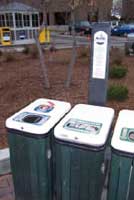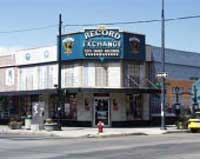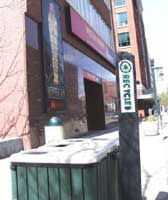Boise City Downtown Recycling

Note: EPA no longer updates this information, but it may be useful as a reference or resource.
Contact: Megan Kershner (mkershner@cityofboise.org), Solid Waste Program Coordinator, 208-384-3901
Boise City’s pedestrian recycling program began in 2001. The goal of the program was to provide a specific transient crowd the opportunity to recycle. More than that, this program was designed to get folks thinking about recycling outside of their homes.
Eight recycling centers are located in downtown Boise for use by employees and visitors to the downtown area. Each recycling center has three separate containers for the collection of aluminum cans, newspaper, and plastic (bottles and cups). The centers are Windsor Barrel Works containers and each set cost approximately $1200 (including shipping). The containers feature top locking steel lids, recycled plastic lumber bases and signposts, locking side doors, rigid liners, and the option of bolting the set to concrete.
This endeavor is a partnership program with Capital City Development Corporation (CCDC) and the Downtown Boise Association(DBA). The city is responsible for site maintenance and collection of materials. The city employs a part-time student intern to collect materials and maintain these recycling centers. Service and maintenance averages four hours per week plus transportation costs.
The locations of the recycling centers were selected based on pedestrian traffic and nearby businesses. Four locations are at or near downtown parks where pedestrians may eat their lunches or stretch their legs. All other locations are in pedestrian corridors and near businesses that sell recyclable materials (water bottles, newspapers, etc.).
Success

The key to a successful pedestrian recycling program is locating recycling centers along pedestrian corridors and near businesses that sell recyclable materials. It is important that recycling centers are adjacent to trash receptacles. People need a choice — if there isn’t one, your recyclables will definitely be contaminated.
Get nearby businesses involved and ask for their support. If they are excited about the program, ask them to be the recycling center “watchdogs” and report problems to you as they occur.
Continually market your program and educate your audience. Advertise at local retail shops and restaurants, and in newspapers. The availability of pedestrian recycling may be a positive advertising angle for business organizations and may attract new people to the area.
Avoid the Pitfalls

Don’t assume you know where your recyclables are generated and where they are moving to. You need to study your area and learn the patterns of pedestrian behavior. The most common mistake is assuming that a recycling bin next to a pop machine is effective. Most people do not consume their soda standing at the machine. You need to predict where that soda can is traveling to and where it will be empty — that’s where you put the recycle bin.
Don’t assume “greenies” always do right. We located one recycling center next to a coffee shop that touts itself as environmentally-friendly and whose clientele includes die-hard recyclers. Interestingly, this location proved to be extremely problematic with excessive contamination in each recycle bin. After struggling for two years to get the recyclables cleaned up and get assistance from the business (and its patrons), we admitted defeat and moved the recycling center.

Don’t assume young people and “suits” don’t care about the environment. We placed a recycling center near a funky coffee shop/record store/hip-Goth bar and expected the worst. We expected the habitually loitering, black-clad, 20-somethings to not care about recycling and to not participate, or worse — set fire to the recycling center. (The phone booth had been replaced six times in one year.) Instead, that is our best recycling center both by volume and cleanliness. We rarely get any contamination at this location and the bins are always full.
Be flexible and be prepared to make changes to your program. If you need to move a container — move it. If you need different messaging at one location versus another, be flexible and design a brand that can meet a variety of audiences. Pedestrian recycling is a living thing — changing seasonally and over time. You must be vigilant and stay tuned into your program to be successful.
![[logo] US EPA](../gif/logo_epaseal.gif)